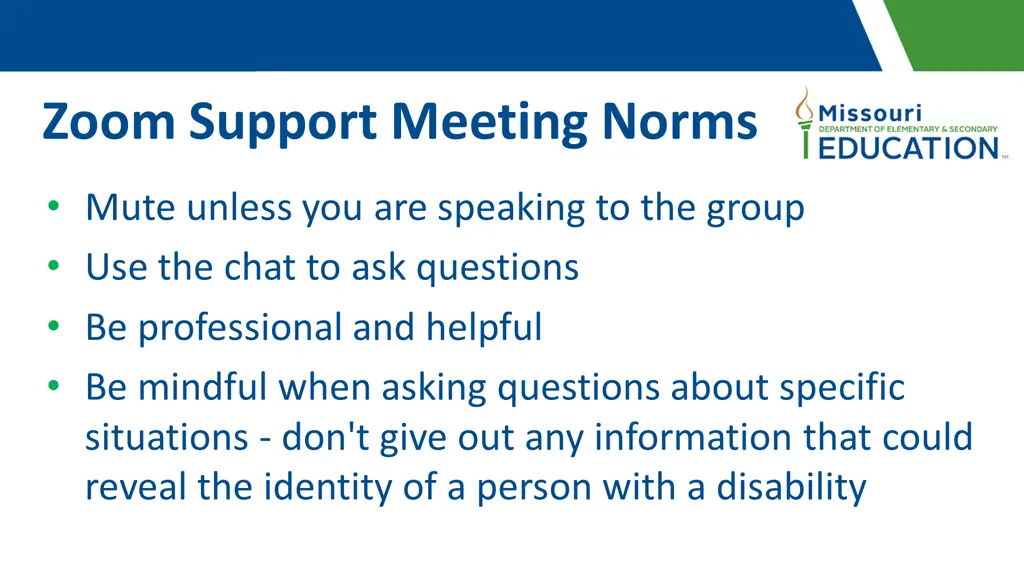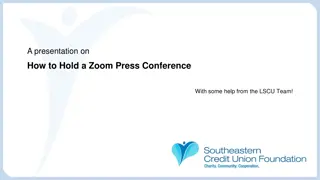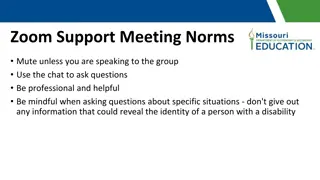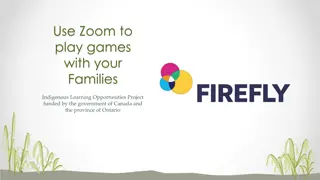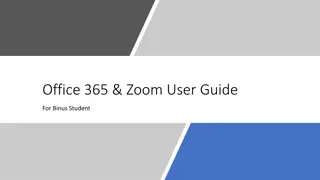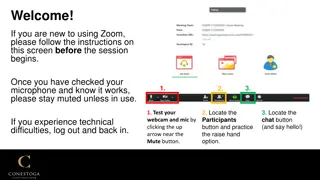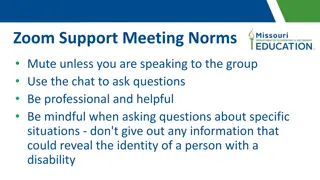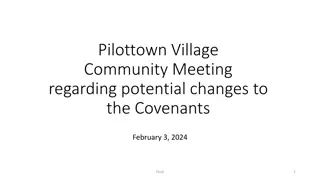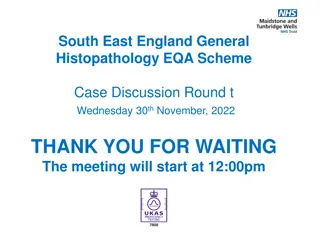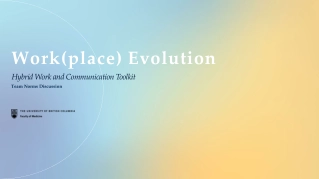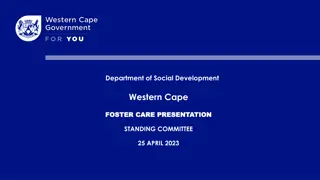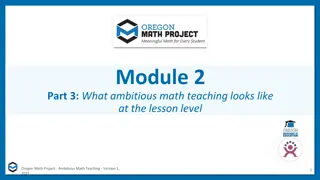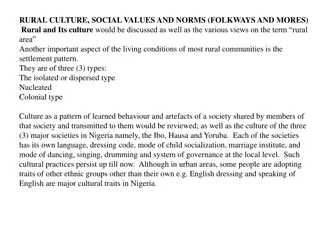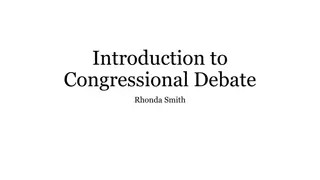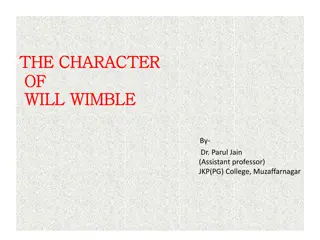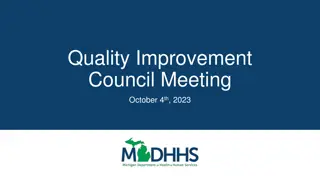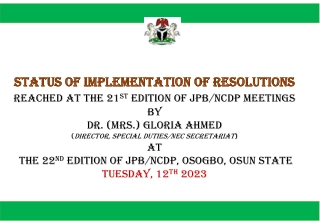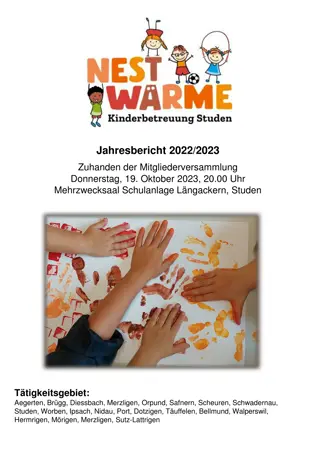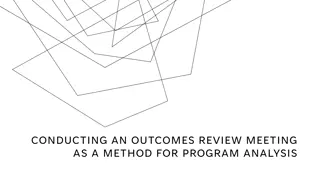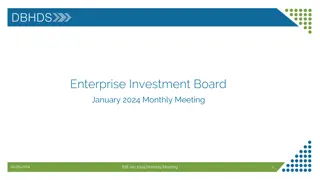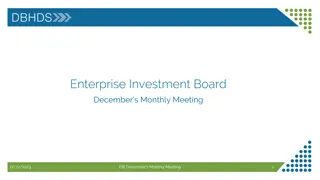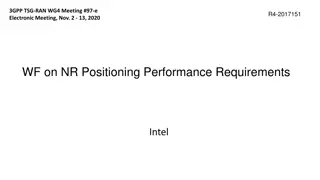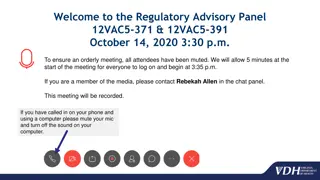Zoom Support Meeting Norms
Follow these meeting norms for Zoom support meetings: mute yourself unless speaking to the group, use chat for questions, be professional and helpful, and be mindful when asking about specific situations.
Download Presentation

Please find below an Image/Link to download the presentation.
The content on the website is provided AS IS for your information and personal use only. It may not be sold, licensed, or shared on other websites without obtaining consent from the author. Download presentation by click this link. If you encounter any issues during the download, it is possible that the publisher has removed the file from their server.
E N D
Presentation Transcript
Zoom Support Meeting Norms Mute unless you are speaking to the group Use the chat to ask questions Be professional and helpful Be mindful when asking questions about specific situations - don't give out any information that could reveal the identity of a person with a disability
April 6, 2023 Compliance Team Emotional Disturbance and Autism: Emotional Disturbance and Autism: Overview of Eligibility Overview of Eligibility
Common Vocabulary: IDEA Definitions Autism Emotional Disturbance 300.8 (c ) (1) Autism means a developmental disability significantly affecting verbal and nonverbal communication and social interaction, generally evident before age three, that adversely affects a child s educational performance. Other characteristics often associated with autism are engagement in repetitive activities and stereotyped movements, resistance to environmental change or change in daily routines, and unusual responses to sensory experiences. 300.8 (c ) (4)Emotional disturbance means a condition exhibiting one or more of the following characteristics over a long period of time and to a marked degree that adversely affects a child s educational performance: (A) An inability to learn that cannot be explained by intellectual, sensory, or health factors. (B) An inability to build or maintain satisfactory interpersonal relationships with peers and teachers. (C) Inappropriate types of behavior or feelings
What are the similarities in eligibility for these two categories? Both require: Observations to be conducted in a variety or multiple settings (see January 20, 2022 webinar on Observations) Multiple sources of data to be used to confirm adverse educational impact Need for special education (specially designed instruction) and related services, if deemed appropriate by IEP team Neither require: Medical diagnosis, but require relevant medical data must be considered Specific cut scores or discrepancy in scores from standardized assessments in order to meet eligibility
5 Things to consider with adverse educational impact Both eligibility criteria include these statements: The evaluation report documents all areas in which the child s autism/emotional disturbance adversely affects her/his educational performance The documentation includes a description of the educational concerns o These specific concerns build the foundation for the impact statements in the PLAAFP
6 What to consider with adverse educational impact Documented evidence MUST support the relationship between the school-related behaviors and or affective relations and decreased educational performance. The definition of educational impact cannot be limited to academics. o March 8, 2007, OSEP Letter to Clark clarified that educational performance as used in IDEA and its implementing regulations is defined as not limited to academic performance
7 What to consider with adverse educational impact When determining if child s emotional disturbance or autism has an adverse effect on educational performance, eligibility teams must consider all aspects of the child s functioning at school, including academic, social/emotional, cognitive, communication, vocational and independent living skills. Adverse impact on educational performance could look like: Self regulation deficits in the educational environment Inability to develop appropriate social relationships Weaknesses in the area of task related skills such as organization and time management Difficulty following directions and rules Chronic absenteeism, tardies, removal from learning environment (removals to office, nurse, OSS, ISS) Inability to communicate effectively with peers and adults
8 What to consider with adverse educational impact Determination of adverse educational performance is not limited to grades. Other data to consider: Intervention progress monitoring reports Achievement test scores Summative and formative assessment data Standards based report cards or standards based assessments Measures of on-going classroom performance Teacher observations (peer comparison data) Work samples Discipline records (school setting, transportation setting) Office referrals School health records Counseling records Outside agency records (counselor notes, doctor s notes, etc)
9 What to consider with adverse educational impact The student s overall performance should demonstrate a marked difference between actual and expected school performance. i.e., when a severe and chronic pattern of failing to persevere with tasks and complete classroom assignments leads to repeated failure in subject matter courses, this could be considered an adverse impact. Documentation of adverse educational impact must also substantiate that these deficiencies persist over time, in spite of specific alternative intervention strategies that have been provided in the general education setting. Determination of adverse educational impact must be made on a case by case basis and is dependent on the unique needs of the particular child (March 8, 2007, Letter to Clark, 48 IDELR 77)
10 Specific criteria for Emotional Disturbance categorical eligibility 10
11 Possible sources of data when suspecting an emotional disturbance Examples of these sources of information should be used to determine the suspicion of the need for special education services, documented on the Review of Existing Data and may be sources used when making an eligibility determination Social emotional behavior screening data School or outside counseling intervention data Small group skill building data Other intervention data Office discipline referrals Nurse visits Amount of time outside of the classroom Observation data Parent/Caregiver interview information Formal assessment data (previous to the evaluation)
800.10 One (1) or more characteristics of emotional disturbance are present The evaluation report documents a comprehensive evaluation which confirms the presence of an emotional disturbance and includes a description of one (1) or more of the following characteristics:
13 800.10 One (1) or more characteristics of emotional disturbance are present 800.10.a. Documentation supports an inability to learn that cannot be explained by intellectual, sensory or health factors inability to learn = significant difficulty in learning despite documentation of targeted, intense intervention and/or support services Must consider cultural, social and linguistic influences on student performance Rule out other primary reasons for behavior: such as intellectual disability, learning disabilities, sensory conditions like hearing/vision impairments, or health factors such as traumatic brain injury, neurological impairments or other medical conditions.
14 800.10 One (1) or more characteristics of emotional disturbance are present 800.10.b. Documentation supports an inability to build or maintain satisfactory interpersonal relationships with peers and teachers Satisfactory interpersonal relationships include the ability to demonstrate: Sympathy Warmth and empathy toward others Establish and maintain friendships Be constructively assertive Work and play independently Examples of characteristics may include but are not limited to: o Physical or verbal aggression when others approach him or her; o Lack of affect or disorganized/distorted emotions toward others; o Demands for constant attention from others; and o Withdrawal from all social interactions
15 800.10 One (1) or more characteristics of emotional disturbance are present 800.10.c. Documentation of inappropriate types of behavior or feelings under normal circumstances These differ significantly from expectations for the student s age, gender, and culture across different environments Examples, but not limited to: o Limited or excessive self-control o Low frustration tolerance, emotional overreactions and impulsivity o Limited premeditation or planning o Limited ability to predict consequences of behavior o Rapid changes in behavior or mood o Excessive dependence and/or inappropriate rebellion and defiance o Low self-esteem and/or distorted self-concept The eligibility team should take into account whether a student s home or school situation is disrupted by stress, recent changes or unexpected events. While students in such situations are not excluded from this category, as they may still be experiencing what constitutes an emotional disturbance, teams should be cautious to prevent the inappropriate identification of students who are reacting to a state of stress (e.g., typical grief cycle over a loss of parent).
16 800.10 One (1) or more characteristics of emotional disturbance are present 800.10.d. Documentation of a general pervasive mood of unhappiness or depression Student s unhappiness or depression is occurring across most, if not all, of the student s life situations. o Consistent pattern of depression or unhappiness to meet extended period of time requirement (in MO this means 2-9 months) o Not temporary response to situational factors or a medical condition o Examples, but not limited to: Depressed or irritable mood most of the time (i.e., feeling sad, appearing tearful) Diminished interest or pleasure in daily activities Significant and unexpected changes in weight or appetite Fatigue or diminished energy nearly every day Feelings of worthlessness or excessive or inappropriate guilt Diminished ability to think or concentrate or indecisiveness nearly every day
17 800.10 One (1) or more characteristics of emotional disturbance are present 800.10.e. Documentation that the student has a tendency to develop physical symptoms or fears associated with personal or social problems. Examples, but not limited to: o Headaches o Gastrointestinal problems o Cardiopulmonary symptoms o Incapacitating feelings of anxiety often accompanied by trembling, hyperventilating and/or dizziness o Panic attacks characterized by physical symptoms, for example, when an object, activity, individual or situation cannot be avoided or is confronted o Persistent and irrational fears of particular objects or situations; and o Intense fears or irrational thoughts related to separations from parents These physical symptoms should adhere to the following conditions: o Symptoms are present with no demonstratable medical findings o Evidence or strong presumption these symptoms are linked to psychological factors o There is evidence to support that the person is not conscious of intentionally producing these symptoms
18 Note The term emotional disturbance includes schizophrenia, but does not apply to children who are socially maladjusted unless it is determined they also have an emotional disturbance
19 Socially Maladjusted A social maladjustment is a persistent pattern of violating societal norms, such as multiple acts of truancy, or substance abuse, or sex abuse, and is marked by struggle with authority, low frustration threshold, impulsivity, or manipulative behaviors. National Association of Special Education Teachers: Eligibility Criteria Checklist for a Classification of an Emotional Disturbance
20 Social maladjustment can look like: Unhappiness or depression that is NOT pervasive Problem behaviors that are goal-directed, self-serving and manipulative Actions based on perceived self-interest even though they may seem self-defeating General social conventions and behavioral standards are understood, but are not accepted and followed Negative counter-cultural standards or peers are accepted and followed Inappropriate behaviors are displayed in selected situations or settings, while other behavior is appropriately controlled Problem behaviors are frequently the result of encouragement by a peer group, are intentional, and the student understands the consequences of such behaviors Problem behaviors have escalated during pre-adolescence or adolescence National Association of Special Education Teachers: Eligibility Criteria Checklist for a Classification of an Emotional Disturbance
21 What MUST the evaluation include? 21
800.20 The evaluation procedures include: The evaluation report includes an analysis of the identified concerns through both of the following methods: 800.20.a Observations of the behavior in different environments, AND 800.20.b An in-depth social history
23 Observations for ED eligibility Must include the following: Student s name Name and role of observer Date and time of observation Name or description of environment in which the child is being observed Clear description of activity that is taking place in environment at time of observation Comparison of target student s behavior to the behavior of same age peers in environment (establishes extent of adverse impact) Description of both adult and student behaviors during observed interactions (assists in defining triggers and consequences of behaviors) In order to collect observational data that aligns with referral concerns, consult with teacher to find out best time to observe
24 An In-Depth Social History Include developmental history and significant life events Can be provided by parents, caregivers, physicians and teachers in various forms Best practice approach is to conduct via interview. This will allow for more in depth information and give the interviewer an opportunity to ask clarifying questions.
25 800.30 Impact of emotional disturbance 800.30.a. The evaluation report documents that the characteristics have exited over an extended period of time Generally, at least 2-9 months depending on age of student and type of behavior occurring A specific crisis or stressful experience MAY preclude the student from consideration of an emotional disturbance AND 800.30.b. The characteristics exist to a marked degree (significantly different in intensity and frequency from peers)
26 Significantly different Social Emotional Development Guidance Grade Level Expectations (link below) Observations indicate skills and behaviors significantly different from typical peers Formal assessments indicate significant variability from the mean https://dese.mo.gov/media/pdf/gle-personal-and-social-development
27 800.40 Adverse effects on educational performance The evaluation report documents: 800.40.a. The adverse impact of the emotional disturbance on educational performance in the school setting see beginning of presentation 800.40.b. A description of educational concerns
28 Need for special education and related services Does the child need special education and related services in order to meet state standards? NOT would they benefit from it What specialized instruction does the student need to address the adverse impact? How does the content, methodology or delivery of instruction need to be adapted to meet the unique needs of the student as a result of their educational disability?
29 Switching Gears to Autism
30 IDEA definition Autism means a developmental disability significantly affecting verbal and nonverbal communication, and social interaction, generally evident by age 3, that adversely affects a child s educational performance.
Diagnosis vs. Eligibility Evaluation Interface between two very different systems of care Health care system and the educational system ASD are defined as both a clinical disorder and an educational disability which results in the need for special education services Considerable overlap but also some significant differences o Clinical diagnosis made by professionals with expertise in evaluating children with a variety of behavioral and emotional disorders, using the DSM V eligibility standards or criteria o Educational disability is determined by a multi-disciplinary team using IDEA eligibility standards
32 Clinical Diagnosis vs. IDEA Eligibility A clinical diagnosis of Autism is not required to meet eligibly under IDEA and Missouri criteria A clinical diagnosis does not automatically equate to IDEA eligibility for Autism Children with a clinical diagnosis may be eligible under one of the other eligibility categories
33 Evaluation procedures A thorough review of what is already known about this student (review of existing data) must be documented Assessments should be conducted by professionals that have the proper training and experience to conduct and interpret the assessments
34 Specific Criteria for Autism categorical eligibility 34
35 600.10 Evaluation procedures include: The evaluation report documents the use of all of the following procedures to address the areas of concern: 600.10.a. Review of medical records Clinical diagnosis of autism not required If there are no medical records or parent will not consent to release the records, this is not a reason to find a child ineligible. If the district determines they need medical information to complete a thorough evaluation and it is not available, the LEA is responsible to provide for that medical evaluation 600.10.b. Observation of the child s behavior across multiple environments 600.10.c. An in-depth social history
36 An In-Depth Social History Include developmental history and significant life events Can be provided by parents, caregivers, physicians and teachers in various forms Best practice approach is to conduct via interview. This will allow for more in depth information and give the interviewer an opportunity to ask clarifying questions.
37 Evaluation Procedures Evaluations could also include information in the following areas, as determined appropriate through the review of existing data: Cognitive skills or developmental level Adaptive skills Social interaction skills Motor development Communication skills Social/emotional functioning (to include a functional behavior assessment, if appropriate) Academic achievement levels (when appropriate) Vocational skills Sensory functioning Hearing/vision screening (additional info as needed) Interview information
38 600.20 Disturbance of the communication process The evaluation report documents disturbances of speech, language- cognitive development, and nonverbal communication in one (1) or more of the following: 600.20.a. Abnormalities that extend beyond speech to many aspects of the communication process 600.20.b. Absence of communicative language or, if present, language lacks communicative intent 600.20.c. Characteristics involve both deviance and delay 600.20.d. Deficits in the capacity to use language for social communication, both receptive and expressive
39 What do those disturbances in the communication process look like? Measures, record reviews, interviews and observations indicate the child s verbal and non-verbal communications are significantly different from peers A lack of typical back and forth social conversation Significant deficits in understanding and using non-verbal communication including eye contact, facial expression, body postures and gestures An absence of verbal language Abnormal volume, pitch, intonation, rate, rhythm, stress, prosody Limited ability to express a range of emotions via words Inability to maintain social discourse (staying on topic, starting at conversation, appropriately ending a conversation)
40 600.30 Disturbance in the capacity to relate appropriately (in addition to 600.20) The evaluation report documents a deficit in the child s capacity to relate appropriately to people, events or objects through one (1) or more of the following ways: 600.30.a. Evidence of abnormalities in relating to people, events or objects 600.30.b. Deficits in capacity to form relationships with people 600.30.c. Use of objects in an age-appropriate or functional manner are absent, arrested, or delayed 600.30.d. Seeks consistency in environmental events to the point of exhibiting rigidity in routines
41 What do disturbances in the capacity to relate appropriately look like? Measures, record reviews, interviews and observations indicate the child s skills in social interactions and relating appropriately are significantly different from peers Significant difficulty sharing, engaging in imaginative play and developing and maintaining friendships Lack of social interactions Abnormal social approaches Inability to take another person s perspective (children above 4 years old) Difficulty adjusting behavior to social contexts Poor social imitation Seeking consistency in environmental events to the point of exhibiting significant rigidity in routines and displays marked distress over changes in routine Significantly persistent preoccupation with or attachment to objects or topics
42 600.40 Adverse effect on educational performance 600.40.a. The evaluation report documents all areas in which the child s autism adversely affects her/his educational performance. 600.40.b. The documentation includes a description of the educational concerns
43 600.50 Autism is not the result of other factors 600.50.a. The evaluation report documents the results of the evaluation and the team s conclusion that the child s autism is not the result of an emotional disability. Co-morbidity of autism and other types of disabilities must be recognized, especially with mental health. If this is a co-occurrence of indicators for both autism and emotional disturbance, the team must determine which is the primary impact on the student s educational performance
44 And, If Appropriate 600.60 And/Or, If Appropriate 600.70 There are some additional characteristics which may be present in a child with ASD, but cannot be the sole basis for determining that a child is eligible in this category if the child does not also meet indicators 600.10 through 600.50
45 600.60 Disturbance of developmental rates and sequences The evaluation report documents deficits in the child s developmental rates and sequences through one (1) or more of the following: 600.60.a. Delays, arrests, or regressions in physical, social or learning skills 600.60.b. Areas of precocious development with other skill areas at normal or extremely depressed rates 600.60.c. Skill acquisition does not follow normal developmental patterns
46 600.70 Disturbance of responses to sensory stimuli The evaluation report documents deficits in the child s responses to sensory stimuli through one (1) or more of the following: 600.70.a. Behavior ranges from hyperactive to unresponsive to people and objects and can alternate between these states over periods ranging from hours to months 600.70.b. Disturbances in auditory, visual, olfactory, gustatory, tactile and kinesthetic responses 600.70.c. Responds to stimulation inappropriately and in repetitive or no meaningful ways
47 Key Points to Remember Conduct a thorough evaluation including observations in a variety of/multiple settings Ensure your evaluation report adequately meets all of the requirements set forth in the Standards and Indicators Manual, specifically the 600 s and 800 s sections Ensure the adverse educational impact is clearly documented in the evaluation report Ensure the evaluation report is comprehensive and addresses all the educational concerns so that a quality IEP/PLAAFP/Goals/Accommodations and Modifications can be written
48 Resources Tennessee Department of Education Emotional Disturbance Evaluation Guidance Colorado ASD 2021 Guidelines Kansas Updated Eligibility Indicators Connecticut Guidelines for Autism Eligibility Missouri Standards and Indicators
